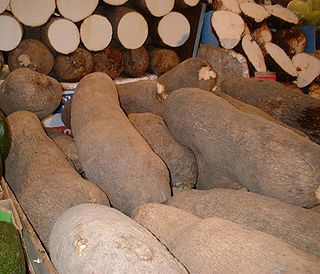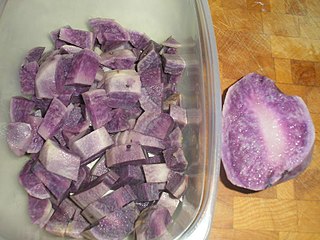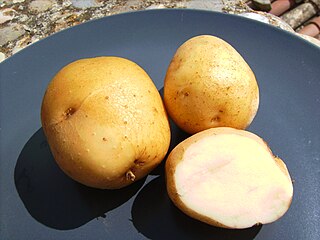Related Research Articles

The potato is a starchy tuber of the plant Solanum tuberosum and is a root vegetable and a fruit native to the Americas. The plant is a perennial in the nightshade family Solanaceae.

Ullucus is a genus of flowering plants in the family Basellaceae, with one species, Ullucus tuberosus, a plant grown primarily as a root vegetable, secondarily as a leaf vegetable. The name ulluco is derived from the Quechua word ulluku, but depending on the region, it has many different names. These include illaco, melloco, chungua or ruba, olluco or papalisa, or ulluma.

Sagittaria latifolia is a plant found in shallow wetlands and is sometimes known as broadleaf arrowhead, duck-potato, Indian potato, katniss, or wapato. This plant produces edible tubers that have traditionally been extensively used by Native Americans.

Russet Burbank is a potato cultivar with dark brown skin and few eyes that is the most widely grown potato in North America. A russet type, its flesh is white, dry, and mealy, and it is good for baking, mashing, and french fries (chips). It is a common and popular potato.

Yam is the common name for some plant species in the genus Dioscorea that form edible tubers. Yams are perennial herbaceous vines cultivated for the consumption of their starchy tubers in many temperate and tropical regions, especially in West Africa, South America and the Caribbean, Asia, and Oceania. The tubers themselves, also called "yams", come in a variety of forms owing to numerous cultivars and related species.

Yukon Gold is a large cultivar of potato most distinctly characterized by its thin, smooth, eye-free skin and yellow-tinged flesh. This potato was developed in the 1960s by Garnet ("Gary") Johnston in Guelph, Ontario, Canada, with the help of Geoff Rowberry at the University of Guelph. The official cross bred strain was made in 1966 and 'Yukon Gold' was finally released into the market in 1980.
Ditylenchus destructor is a plant pathogenic nematode commonly known as the potato rot nematode. Other common names include the iris nematode, the potato tuber eelworm and the potato tuber nematode. It is an endoparasitic, migratory nematode commonly found in areas such as the United States, Europe, central Asia and Southern Africa.

The 'Adirondack Blue' is a potato variety with blue flesh and skin with a slight purple tint, released by Cornell University potato breeders Robert Plaisted, Ken Paddock, and Walter De Jong in 2003.
Bloomer is a potato variety. Bloomers produce round purplish-blue tubers with fairly deep eyes. The flesh is cream coloured.
Black Champion is a variety of potato with purple skin colour that produces round, flattened tubers. Davidson (1936) described this as an old variety found growing in the Midlands of Ireland but of no commercial value. Noted by Kehoe (1986) as being unique to the Irish potato collection.
Skerry Champion is a variety of potato with a round-to-oval shape and creamy yellow skin with a beautiful blue/purple "birthmark" colouring. 'Skerry Champions' have only recently become available to growers again after a long period of absence due to a host of viral diseases it was carrying. Taste quality is excellent with a lovely flavour and floury texture. They are quite highly resistant to blight however the tops of diseased haulms should be removed to keep tubers healthy. It has also been known as Buchan Beauty and although introduced into Ireland in 1922, may have existed in the UK before then.

Irish White is a variety of potato that was traditionally grown in County Donegal and Antrim. It was raised by Robert Christie of Ballytaggart about 1882.
The Ulster Emblem variety of potato originated in Northern Ireland. It was originally bred by Mr J. Clarke of Ballymoney, Co. Antrim. It has a long oval shape with white skin and flesh which has a semiwaxy texture, reasonable flavour with good cooking quality, and a fairly good yield. This variety has a red violet coloured flower and a pink sprout colour. It also has a high resistance to late blight on the tubers as well as the plant foliage.
Champion is a potato variety bred by John Nicoll in Scotland and widely grown in Ireland during the latter half of the 19th century. The tuber is round, with white skin and yellow flesh. The texture is described as "floury".

Kennebec is a medium- to late-maturing white potato. It was bred by the USDA and selected by Presque Isle Station, Maine, in 1941. Kennebec is not under plant variety protection. This fast-growing variety has high yields. It maintains good quality in storage and is grown for both fresh market use and for potato chip manufacturing.
The Ranger Russet is a late-maturing potato that is used for baking and processing into fries. It was originally bred by Joseph J. Pavek of the USDA in Aberdeen, Idaho, and released jointly by the USDA and the agricultural stations of Idaho, Washington, Oregon and Colorado in 1991. Ranger Russet is not under plant variety protection. It yields medium to high numbers of tubers with a short dormancy period.
Austrian Crescent is a medium maturing yellow potato variety. It is grown for specialty markets and stores well. It can be used in salads or for roasting.
Fusarium dry rot is one of the most common potato diseases. It is caused by fungi in the genus Fusarium. This fungi causes a variety of colored rots in potatoes. This pathogen, while having both a sexual and asexual form, stays in an asexual cycle due to the way it spreads. Preferring warmer climates, it is not uncommon to find this pathogen in the northern United States where it has been reported to affect yield as much as 60%.

A staple food, food staple, or simply a staple, is a food that is eaten often and in such quantities that it constitutes a dominant portion of a standard diet for a given person or group of people, supplying a large fraction of energy needs and generally forming a significant proportion of the intake of other nutrients as well. A staple food of a specific society may be eaten as often as every day or every meal, and most people live on a diet based on just a small number of food staples. Specific staples vary from place to place, but typically are inexpensive or readily available foods that supply one or more of the macronutrients and micronutrients needed for survival and health: carbohydrates, proteins, fats, minerals, and vitamins. Typical examples include tubers and roots, grains, legumes, and seeds. Among them, cereals, legumes, tubers, and roots account for about 90% of the world's food calories intake.
References
- ↑ Irish Seed Savers Spring 2010 Seed List
